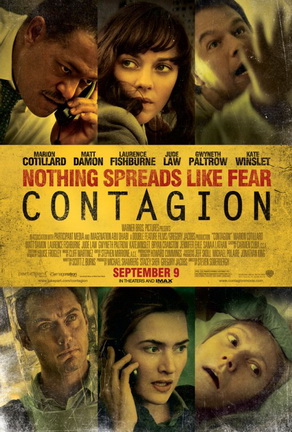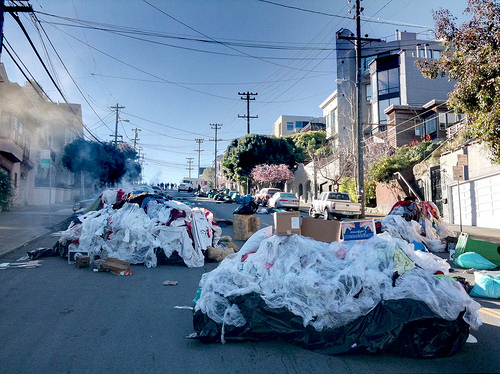Movie review: "Contagion"
The title of the 2011 movie “Contagion” refers to the deadly infectious disease sweeping over the world that drives its plot — but also to the social contagion that spreads even farther and faster than the killer virus.
In fact, it’s this second aspect of “Contagion” that’s by far the most interesting. As an enemy, the virus is about as inhuman as you can get — it infects you, or it doesn’t. People with the virus die, or they don’t. Treatment appears to be largely ineffective — the drive of the movie’s plot is towards finding a vaccine to prevent transmission of the MEV-1 virus, not finding a way to keep people with the virus alive.
But the world’s population who are not infected still have to survive until they can be inoculated. And for many, the social contagion proves a more immediate danger than the actual virus.

I’ve read that the movie’s science is actually pretty accurate about the process of creating a vaccine for a new virus — and amazingly accurate for Hollywood science. That’s great, but I’m a reporter, not a scientist, so I’ll cheer scientific accuracy and focus on what’s more my forte: the transmission of ideas.
(The below contains some moderate spoilers for the movie.)
The driving social factor in contagion is the scarcity of accurate information. The experts — doctors, scientists and government bureaucrats — know little about the disease, and the general public knows even less. When the price of not knowing how to protect oneself from MEV-1 can be death, people understandably desperately seek out that information, even when it’s not accurate.
That’s the focus of the subplot about the freelance journalist Alan Krumwiede (Jude Law), who proclaims loud and wide that the real cure for MEV-1 is a homeopathic remedy based on the Forsythia flower. Forsythia turns out to be nothing more than a placebo, but one with the dangerous side effect of falsely persuading people they’re immune to the disease. When the only sure way to avoid a disease is “social distancing,” or avoiding contact with anyone who might be infected, a bunch of people falsely believing they can safely go out in public only helps the disease spread further.
My biggest gripe with this subplot is the unnecessary revelation that Krumwiede was promoting Forsythia for selfish reasons. This serves to make him more villainous, but many people promoting junk science like homeopathy or opposition to vaccines do so out of heartfelt convictions that they’re right. It’d have been a bolder statement on the part of the filmmakers to make Krumwiede a lesson in bad science, not corruption.

Right: Garbage piled up in the streets for the movie “Contagion,” which looks in part at the decay of the social order when an infectious pandemic strikes humanity. (Image via Todd Lappin, used via Creative Commons Attribution-Noncommercial license: http://dmont.co/2w)
Much like bad information, fear is also contagious. Once it sinks in among the public just how deadly the disease is, people realistically panic. There are riots in the stores over limited supplies of the Forsythia placebo. Emergency personnel — even the vitally needed medical personnel — go on strike rather than expose themselves to MEV-1 by interacting with the sick. Rather than nurses, the people treating MEV-1 victims at makeshift clinics are shown to be volunteers like nuns. Garbage collection ceases, and survivors simply throw their trash out into the streets — providing the most dynamic visual evidence of society grinding to a halt. Other people, driven to desperation or greed, turn to crime and start breaking into homes and businesses to loot.
All this goes to demonstrate just how much of modern life is based on a delicate balance — a combination of social compact and incentives. Most people generally agree to respect other people’s rights, and society offers rewards to people who comply and punishments for people who don’t. But upset this balance, snap those social ties, and everything falls apart.
That’s the dilemma of “Contagion.” The only surefire way to keep yourself safe is social distancing, to avoid social contact with potential disease carriers. But our lives are built around that social contact. We acquire food and medicine and dispose of waste through social interaction, not the work of our own hands. While relatively few people would suggest we’d be better off with a society where we had to produce all our own inputs, this sort of hyperspecialized society rests on a tenuous basis, and something like MEV-1 could easily upset this.
Per the movie’s own math, fear does indeed spread more widely than the disease. Though every significant character we see get the disease dies, worldwide MEV-1 is said to have only a 25 percent mortality rate. (That’s actually a lot, generally speaking — the 1918 influenza epidemic killed around 3 percent of the people it infected.) I can’t find the reference to what the infection rate of MEV-1 was, but if it was also 25 percent, we’re talking the deaths of 1/16 of the world population. With the world’s population just hitting 7 billion, that’s around 500 million people dead. Five hundred million deaths is enormous, of course, but this isn’t a plague that’s going to wipe out humanity. The potential for widespread disruption as people try to avoid the plague is what has the potential to disrupt civilization. In contrast, the Black Death in medieval Europe killed anywhere between 30 and 80 percent of the population in the regions it infected, a death rate that did have massive societal consequences.
In “Contagion,” on the contrary, even as the social fabric fractures, it does not disintegrate. Vestiges of order remain. The National Guard is called out, and members heroically respond to guard supplies and facilities and to maintain order. When scientists believe they have a vaccine, it’s put into production and distribution in a highly regular fashion. Though “Contagion” looks in many ways at a worst-case scenario, in the end it’s optimistic: even a deadly, infectious disease like MEV-1 does not destroy society, only tests it. Human ingenuity, institutions and resilience prove more powerful than nature’s instruments of death.
(End spoilers.)
Some of the many interweaving plots of “Contagion” are less interesting than others — the sideplot of Marion Cotillard’s character being kidnapped seems particularly extraneous — but the acting is generally well done. Cinematically director Steven Soderbergh does a great job of creating tension and dramatizing the plague, with his insistent cutaways to all the transmission vectors particularly unsettling. Combine that technical sophistication with a movie that takes a smart, provocative look at how a possible (if unlikely) scenario would test modern society, and don’t deduct any points for Hollywood pseudoscience, and “Contagion” ends up as a solid, if not perfect movie. Recommended.